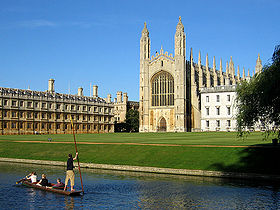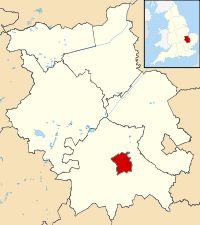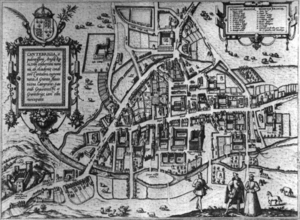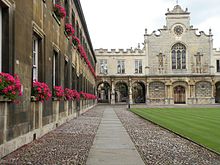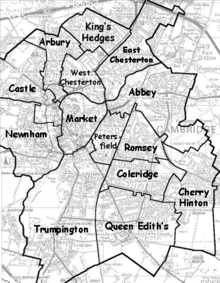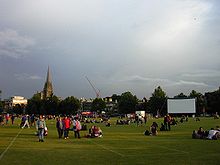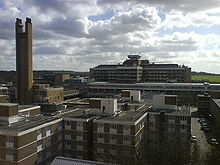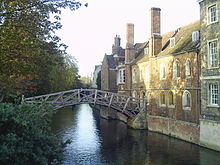- Cambridge
-
This article is about the city in England. For other uses, see Cambridge (disambiguation).
City of Cambridge — Non-metropolitan district, city — King's College Chapel, seen from the Backs 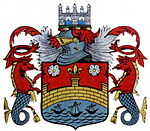
Coat of Arms of the City CouncilCambridge shown within Cambridgeshire Coordinates: 52°12′29″N 0°7′21″E / 52.20806°N 0.1225°E Sovereign state United Kingdom Constituent country England Region East of England Ceremonial county Cambridgeshire Admin HQ Cambridge City Centre Founded 1st century City status 1951 Government – Type Non-metropolitan district, city – Governing body Cambridge City Council – Mayor Ian Nimmo-Smith – MPs: Julian Huppert (LD)
Andrew Lansley (C)Area – Non-metropolitan district, city 44.7 sq mi (115.65 km2) Elevation 20 ft (6 m) Population (2010 est.) – Non-metropolitan district, city 125,700 (ranked 164th) – Urban 130,000 (est.)
(Cambridge Urban Area)– County 752,900 – Ethnicity[1] 73.8% White British
1.3% White Irish
9.8% White Other
2.2% Mixed Race
5.5% British Asian
5.1% Chinese and other
2.3% Black BritishTime zone Greenwich Mean Time (UTC+0) – Summer (DST) BST (UTC+1) Postcode CB1 – CB5 Area code(s) 01223 ONS code 12UB OS grid reference TL450588 Website www.cambridge.gov.uk The city of Cambridge (
 i/ˈkeɪmbrɪdʒ/ kaym-brij) is a university town and the administrative centre of the county of Cambridgeshire, England. It lies in East Anglia about 50 miles (80 km) north of London. Cambridge is at the heart of the high-technology centre known as Silicon Fen – a play on Silicon Valley and the fens surrounding the city.
i/ˈkeɪmbrɪdʒ/ kaym-brij) is a university town and the administrative centre of the county of Cambridgeshire, England. It lies in East Anglia about 50 miles (80 km) north of London. Cambridge is at the heart of the high-technology centre known as Silicon Fen – a play on Silicon Valley and the fens surrounding the city.Cambridge is well known as the home of the University of Cambridge. The university includes the renowned Cavendish Laboratory, King's College Chapel, and the Cambridge University Library. The Cambridge skyline is dominated by the last two buildings, along with the chimney of Addenbrooke's Hospital in the far south of the city and St John's College Chapel tower in the north.
According to the United Kingdom Census 2001, the city's population was 108,863 (including 22,153 students), and the population of the urban area (which includes parts of the neighbouring South Cambridgeshire district) is estimated to be 130,000.
Contents
History
Prehistory
Settlements have existed around the Cambridge area since before the Roman Empire. The earliest clear evidence of occupation is the remains of a 3,500-year-old farmstead discovered at the site of Fitzwilliam College.[2] There is further archaeological evidence through the Iron Age, a Belgic tribe having settled on Castle Hill in the 1st century BC.[3]
Roman times
Main article: DuroliponteThe first major development of the area began with the Roman invasion of Britain in about AD 40. Castle Hill made Cambridge a useful place for a military outpost from which to defend the River Cam. It was also the crossing point for the Via Devana which linked Colchester in Essex with the garrisons at Lincoln and the north. This Roman settlement has been identified as Duroliponte.
The settlement remained a regional centre during the 350 years after the Roman occupation, until about AD 400. Roman roads and walled enclosures can still be seen in the area.
Duroliponte means bridge over the duro or duroli, which appears to derive from the celtic word for water.
Saxon and Viking age
After the Romans had left Saxons took over the land on and around Castle Hill and renamed it Grantabrycge – 'Bridge over Granta'. Their grave goods have been found in the area. During Anglo-Saxon times Cambridge benefited from good trade links across the hard-to-travel fenlands. By the 7th century the town was less significant, described by Bede as a "little ruined city" containing the burial site of Etheldreda.[4] Cambridge is mentioned in the Anglo-Saxon Chronicle as "Grantebrycge", a period when settlements existed on both sides of the river and Cambridge was on the border of East Anglian and Middle Anglian kingdoms.[4]
The arrival of the Vikings in Cambridge was recorded in the Anglo-Saxon Chronicle in 875. Viking rule, the Danelaw, had been imposed by 878[5] The Vikings' vigorous trading habits caused Cambridge to grow rapidly. During this period the centre of the town shifted from Castle Hill on the left bank of the river to the area now known as the Quayside on the right bank.[5] After the Viking period the Saxons enjoyed a brief return to power, building St Bene't's Church[6] in 1025, which still stands in Bene't Street.
Norman times
In 1068, two years after his conquest of England, William of Normandy built a castle on Castle Hill.[4] Like the rest of the newly conquered kingdom, Cambridge fell under the control of the King and his deputies. The distinctive Round Church dates from this period. By Norman times the name of the town had mutated to Grentabrige or Cantebrigge (Grantbridge), while the river that flowed through it was called the Granta.[citation needed]
Over time the name of the town changed to Cambridge, while the river Cam was still known as the Granta – the Upper River between the Millpond in Cambridge and Grantchester is still known as the Granta to this day.[citation needed] It was only later that the river became known as the Cam, by analogy with the name Cambridge. The University, formed 1209, uses a Latin adjective cantabrigiensis (often contracted to "Cantab") to mean "of Cambridge", though this is a back-formation from the English name.[citation needed]
Beginnings of the university
In 1209, students escaping from hostile townspeople in Oxford fled to Cambridge and formed a university there.[7] The oldest college that still exists, Peterhouse, was founded in 1284.[8] One of the most well-known buildings in Cambridge, King's College Chapel, was begun in 1446 by King Henry VI.[9] The project was completed in 1515 during the reign of King Henry VIII.[9]
Cambridge University Press originated with a printing licence issued in 1534. Hobson's Conduit, the first project to bring clean drinking water to the town centre, was built in 1610 (by the Hobson of Hobson's choice). Parts of it survive today. Addenbrooke's Hospital was founded in 1766. The railway and Cambridge station were built in 1845.
Twentieth century
From the 1930s to the 1980s the size of the city was greatly increased by several large council estates planned to hold London overspill.[citation needed] The biggest impact has been on the area north of the river, which are now the estates of Arbury, East Chesterton and King's Hedges, and there are many smaller estates to the south of the city.
During World War II Cambridge served as an evacuation centre for over 7,000 people from London, as well as for parts of the University of London.[10] The town became a military centre, with an R.A.F. training centre and the regional headquarters for Norfolk, Suffolk, Essex, Cambridgeshire, Huntingdonshire, Hertfordshire, and Bedfordshire established during the conflict.[10]
In 1962 Cambridge's first shopping arcade, Bradwell's Court, opened on Drummer Street, though this was demolished in 2006.[11] Other shopping arcades followed at Lion Yard, which housed a relocated Central Library for the city, and the Grafton Centre which replaced Victorian housing stock which had fallen into disrepair in the Kite area of the city. Both of these projects met strong opposition at the time.[12][13]
The city gained its second University in 1992 when Anglia Polytechnic became Anglia Polytechnic University. Renamed Anglia Ruskin University in 2005, the institution has its origins in the Cambridge School of Art opened in 1858 by John Ruskin. The Open University also has a presence in the city, with an office operating on Hills Road.
Despite having a university, Cambridge was not granted its city charter until 1951. Cambridge does not have a cathedral, traditionally a prerequisite for city status, instead falling within the Church of England Diocese of Ely. Many of the buildings in the centre are colleges affiliated to the University of Cambridge, including King's College and Magdalene College. Colleges such as Trinity College and St John's College own significant land both in Cambridge and outside: Trinity is the landlord for the Cambridge Science Park,[14] and also the port of Felixstowe; St John's is the landlord of St John's Innovation Centre near to the Science Park,[15] and many other buildings in the city centre.
Cambridge City Council plans to renew the area around the Corn Exchange concert hall, and plans for a permanent ice-skating rink are being considered after the success of a temporary one that has been on Parker's Piece every year for the past few years.[16] New housing and developments have continued through the 21st century, with estates such as the CB1[17] and Accordia schemes near the station,[18] and developments such as Clayfarm[19] and Trumpington Meadows[20] planned for the south of the city.
Governance
Local government
See also: Cambridge local electionsCambridge is a non-metropolitan district served by Cambridge City Council. The City of Cambridge is one of five districts within the county of Cambridgeshire, and is bordered on all sides by the mainly rural South Cambridgeshire district. Indeed, it is the only district in England to be entirely surrounded by another.[citation needed] The city council's headquarters are in the Guildhall,[21] a large building in the market square. City councillors elect a mayor annually. Cambridge was granted a Royal Charter by King John in 1207, which permitted the appointment of a Mayor,[22] although the first recorded Mayor, Harvey FitzEustace, served in 1213.[23] Cambridge is also served by Cambridgeshire County Council.
For electoral purposes the city is divided into 14 wards: Abbey, Arbury, Castle, Cherry Hinton, Coleridge, East Chesterton, King's Hedges, Market, Newnham, Petersfield, Queen Edith's, Romsey, Trumpington, and West Chesterton.
The political composition of the city council is currently:[24]
- 25 Liberal Democrat councillors
- 14 Labour councillors
- 2 Green councillors
- 1 Independent councillor
The Liberal Democrats have controlled the city council since 2000.
Westminster
See also: Cambridge (UK Parliament constituency)The parliamentary constituency of Cambridge covers most of the city. Julian Huppert (Liberal Democrat) was elected Member of Parliament (MP) at the 2010 general election, succeeding David Howarth. One area of the city, Queen Edith's ward,[25] lies in the South Cambridgeshire constituency, whose MP is Andrew Lansley (Conservative), elected in 1997. The city had previously elected a Labour MP from 1992 to 2005 and prior to this, usually elected a Conservative after the Second World War. However, the Conservatives have seen their share of the vote fall over the past 20 years.
The University of Cambridge used to have a seat in the House of Commons, Sir Isaac Newton being one of the most notable holders. The Cambridge University constituency was abolished under 1948 legislation, and ceased at the dissolution of Parliament for the 1950 general election, along with the other university constituencies.
Geography

Girton Histon and Impington Milton Fen Ditton 
Coton 
Teversham  Cambridge
Cambridge 

Grantchester Great Shelford Fulbourn Cambridge is about 50 miles (80 km) north-by-east of London. The city is located in an area of level and relatively low-lying terrain just south of the Fens, which varies between 6 metres (20 ft) and 24 metres (79 ft) above sea level.[26] The River Cam flows through the city north from the village of Grantchester. The name 'Cambridge' is derived from the river.[27]
Like most cities, modern-day Cambridge has many suburbs and areas of high-density housing. The city centre of Cambridge is mostly commercial, historic buildings, and large green areas such as Jesus Green, Parker's Piece and Midsummer Common. Many of the roads in the centre are pedestrianised.
Climate
Cambridge currently has two official weather observing stations, the National Institute of Agricultural Botany (NIAB), about 2 miles north of the city centre, and the Botanical Gardens, about 1 mile south of the city centre. The city, like most of the UK, has a maritime climate highly influenced by the gulf stream. This is moderated to some extent by its low lying, inland, and easterly position within the British Isles, meaning summer temperatures in particular tend to be somewhat higher than areas further west, and often rival or even exceed those recorded in the London area. July 2006 for example recorded the highest official mean monthly maximum (i.e. averaged over the entire month) of any month at any location in the UK since records began; 28.3 °C (82.9 °F),at both the NIAB[28] and Botanical Gardens[29] observing stations – Cambridge also often records the annual highest national temperature in any given year – 30.2 °C (86.4 °F) in July 2008 at NIAB[30] and 30.1 °C (86.2 °F) in August 2007 at the Botanical Gardens[31] are two recent examples. The absolute maximum stands at 36.9 °C (98.4 °F)[32] set on the 10 August 2003, although a temperature of 37.5 °C (99.5 °F)[33] was recorded on the same day at the Guildhall rooftop weather station in the city centre and is acknowledged by the Met Office. Before this, the absolute maximum was 36.5 °C (97.7 °F) set at the Botanical Gardens[34] in August 1990. The last time the temperature exceeded 35 °C (95 °F) was July 2006 when the maximum reached 35.6 °C (96.1 °F) at the Botanical Gardens[35] and 35.8 °C (96.4 °F) at NIAB.[36] Typically the temperature will reach 25.1 °C (77.2 °F) or higher on 20.5 days of the year over the 1971–2000 period,[37] with the annual highest temperature averaging 30.2 °C (86.4 °F)[38] over the same period.
The absolute minimum temperature recorded at the Botanical Gardens site was −17.2 °C (1.0 °F), recorded in February 1947[39] Although a minimum of −17.8 °C (−0.0 °F) was recorded at the now defunct observatory site in December 1879.[40] The last time the temperature fell below −15.0c was in January 1982 when −16.1 °C (3.0 °F)[41] was recorded. Most recently the temperature fell to −10.9 °C (12.4 °F)[42] on the 20 December 2010. The average frequency of air frosts ranges from 41.9 days at the NIAB site,[43] to 47.2 days at the Botanical Gardens[44] per year over the 1971–2000 period. Typically the coldest night of the year at the Botanical gardens will fall to −8.2 °C (17.2 °F).[45] Such minimum temperatures and frost averages are typical for inland areas across much of southern and central England.
Rainfall is generally low, averaging around 550 to 560 mm (21.65 to 22.05 in) per year, with some years occasionally falling into the semi-arid (under 500 mm (19.69 in) of rain per year) category. Last time this occurred was in 2005 with 495.1mm[46] of rain. Snowfall accumulations, though occurring most years, are similarly small, helped by some extent due to Cambridge's low elevation and low precipitation tendency during transitional snow events.
Sunshine averages around 1500 hours a year or around 35% of possible, a level typical of most locations throughout inland central England.
Climate data for Cambridge Botanical Gardens, elevation 12m,1971–2000, extremes 1914– Month Jan Feb Mar Apr May Jun Jul Aug Sep Oct Nov Dec Year Record high °C (°F) 14.9
(58.8)18.8
(65.8)23.9
(75.0)26.1
(79.0)31.1
(88.0)34.0
(93.2)35.6
(96.1)36.9
(98.4)33.9
(93.0)29.3
(84.7)21.1
(70.0)15.8
(60.4)36.9
(98.4)Average high °C (°F) 7.0
(44.6)7.6
(45.7)10.4
(50.7)13.0
(55.4)16.9
(62.4)19.8
(67.6)22.6
(72.7)22.5
(72.5)19.1
(66.4)14.9
(58.8)10.1
(50.2)7.9
(46.2)14.3 Average low °C (°F) 1.2
(34.2)0.9
(33.6)2.7
(36.9)4.0
(39.2)6.8
(44.2)9.7
(49.5)11.9
(53.4)11.8
(53.2)9.7
(49.5)6.8
(44.2)3.5
(38.3)2.1
(35.8)6.0 Record low °C (°F) −16.1
(3.0)−17.2
(1.0)−11.7
(10.9)−6.1
(21.0)−4.4
(24.1)−0.6
(30.9)2.2
(36.0)3.3
(37.9)−2.2
(28.0)−6.1
(21.0)−13.3
(8.1)−15.6
(3.9)−17.2
(1.0)Precipitation mm (inches) 44.79
(1.7634)32.56
(1.2819)41.72
(1.6425)42.44
(1.6709)45.03
(1.7728)53.70
(2.1142)41.85
(1.6476)48.46
(1.9079)53.34
(2.1)54.35
(2.1398)51.39
(2.0232)50.31
(1.9807)559.94
(22.0449)Source: KNMI[47] Climate data for Cambridge NIAB, elevation 26m,1971–2000 Month Jan Feb Mar Apr May Jun Jul Aug Sep Oct Nov Dec Year Average high °C (°F) 7.0
(44.6)7.4
(45.3)10.2
(50.4)12.6
(54.7)16.5
(61.7)19.4
(66.9)22.2
(72.0)22.3
(72.1)18.9
(66.0)14.6
(58.3)9.9
(49.8)7.8
(46.0)14.1 Average low °C (°F) 1.3
(34.3)1.1
(34.0)2.9
(37.2)4.0
(39.2)6.7
(44.1)9.8
(49.6)12.0
(53.6)11.9
(53.4)10.1
(50.2)7.1
(44.8)3.7
(38.7)2.3
(36.1)6.1 Precipitation mm (inches) 45.0
(1.772)32.7
(1.287)41.5
(1.634)43.1
(1.697)44.5
(1.752)53.8
(2.118)38.2
(1.504)48.8
(1.921)51.0
(2.008)53.8
(2.118)51.1
(2.012)50.0
(1.969)553.5
(21.791)Sunshine hours 55.5 72.6 107.0 145.8 189.7 180.0 191.3 186.9 141.6 115.0 68.1 47.7 1,501.2 Source: Met Office[48] Demography
The demography in Cambridge changes considerably in and out of University term times, so can be hard to measure.
In the 2001 Census held during University term, 89.44% of Cambridge residents identified themselves as white, compared with a national average of 92.12%.[49] Within the University, 84% of undergraduates and 80% of post-graduates identify as white (including overseas students).[50]
Cambridge has a much higher than average proportion of people in the highest paid professional, managerial or administrative jobs (32.6% vs. 23.5%)[51] and a much lower than average proportion of manual workers (27.6% vs. 40.2%).[51] In addition, a much higher than average proportion of people have a high level qualification (e.g. degree, Higher National Diploma, Masters and PhDs), (41.2% vs. 19.7%).[52]
Historical population of Cambridge
Year Population 1801 10,087 1811 11,108 1821 14,142 1831 20,917 1841 24,453 1851 27,815 1861 26,361 Year Population 1871 30,078 1881 35,363 1891 36,983 1901 38,379 1911 40,027 1921 59,264 1931 66,789 Year Population 1941 Data unavailable 1951 81,500 1961 95,527 1971 99,168 1981 87,209 1991 107,496 2001 108,863 Census: Regional District 1801–1901[53] Civil Parish 1911–1961[54] District 1971–2001[55]
Economy
Cambridge and its surrounds are sometimes referred to as Silicon Fen, an allusion to Silicon Valley, because of the density of high-tech businesses and technology incubators that have developed on science parks around the city. Many of these parks and buildings are owned or leased by university colleges, and the companies often have been spun out of the university.[citation needed] Such companies include Abcam, CSR, ARM Limited, CamSemi, Jagex and Sinclair. Microsoft chose to locate its Microsoft Research UK offices in a University of Cambridge technology park, separate from the main Microsoft UK campus in Reading.
Cambridge was also the home of Pye Ltd., who made radios and televisions and also defence equipment. In later years Pye evolved into several other companies including TETRA radio equipment manufacturer Pye Telecommunications. Another major business is Marshall Aerospace located on the eastern edge of the city. The Cambridge Network keeps businesses in touch with each other. The FTSE100 software company Autonomy Corporation is located at the Business Park on Cowley Road.
Transport
Main article: Transport in CambridgeCambridge is a city with many transport connections as well as being one of the UK's eleven "Cycling Cities", a status given in 2008. There are regular trains to King's Cross and Liverpool Street stations in London as well as to Peterborough, Leicester, King's Lynn, Norwich, Ipswich and Stansted Airport. Two major roads pass by the outskirts of the city, the M11 motorway and the A14. Cambridge also has its own airport, Marshall's Airport. The Cambridgeshire Guided Busway connects Cambridge with St Ives and Huntingdon. Cambridgeshire County Council has also submitted a bid for £500 million from the Transport Innovation Fund.
Education
See also: List of schools in CambridgeshireCambridge's two universities,[56] the collegiate University of Cambridge and the local campus of Anglia Ruskin University, serve around 30,000 students, by some estimates.[57] Cambridge University estimated its 2007/08 student population at 17,662,[58] and Anglia Ruskin reports 24,000 students across its two campuses (one of which is outside Cambridge, in Chelmsford) for the same period.[59] State provision in the further education sector includes Hills Road Sixth Form College, Long Road Sixth Form College, and Cambridge Regional College.
Both state and independent schools serve Cambridge pupils from nursery to secondary school age. State schools are administered by Cambridgeshire County Council, which maintains 251 schools in total,[60] 35 of them in Cambridge city.[61] Netherhall School, Chesterton Community College, the Parkside Federation (comprising Parkside Community College and Coleridge Community College), Manor Community College and the Christian inter-denominational St. Bede's School provide comprehensive secondary education.[62] Many other pupils from the Cambridge area attend village colleges, an educational institution unique to Cambridgeshire, which serve as secondary schools during the day and adult education centres outside of school hours.[63] Private schools in the city include The Perse School, The Perse School for Girls, St. Mary's School and The Leys School.[64]
Culture
Sport
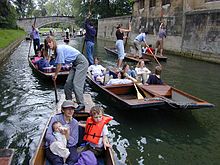 Punting on the River Cam is a popular recreation in Cambridge
Punting on the River Cam is a popular recreation in Cambridge
Football
Cambridge played a unique role in the invention of modern football: the game's first set of rules were drawn up by members of the University in 1848. The Cambridge Rules were first played on Parker's Piece and had a "defining influence on the 1863 Football Association rules."[65]
The city is home to Cambridge United F.C., who played in the Football League at the Abbey Stadium from 1970 to 2005, when they were relegated to Conference National, the division in which they currently compete. When relegation became inevitable the club was placed in administration with substantial debts, but it emerged from administration in time for the 2005–06 season. The club's biggest success came in the early 1990s, with two successive promotions, two successive FA Cup quarter-final appearances, a run to the Football League Cup quarter-finals, and reaching the brink of promotion to the new Premier League.
The city's other football club Cambridge City F.C. play in the Southern Football League Premier Division at the City Ground in Chesterton. Histon, just north of Cambridge, is home to Conference North side Histon F.C..
Cricket
As well as being the home of the Cambridge Rules in football, Parker's Piece was used for first-class cricket matches from 1817 to 1864.[66] The University of Cambridge's Cricket ground, Fenner's, is located in the city and is one of the home grounds for minor counties team Cambridgeshire CCC.[67] There are seven amateur cricket clubs within the city: Cambridge Granta, Camden, Cambridge St Giles, New Chesterton Institute, Fen Ditton, Romsey Town and Cherry Hinton.[68]
Rugby
The city is represented in both codes of Rugby football. Rugby Union club Cambridge R.U.F.C. play in National Division One at their home ground, Volac park on Grantchester Road in the southwest corner of the city. Cambridge Eagles Rugby League team play in the National Conference League East Section during the summer months.
Watersports
The River Cam running through the city centre is used for boating. The University has its own rowing club, Cambridge University Boat Club, and most of the individual colleges have boathouses on the river. The main focus of university rowing life are the two sets of bumps races held at the end of the Lent and Easter terms. Cambridgeshire Rowing Association was formed in 1868 and organises competitive rowing on the river outside of the University.[69] Shallower parts of the Cam are used for recreational punting, a type of boating in which the craft is propelled by pushing against the river bed with a quant pole.
Other sports
Cambridge is home to two Real Tennis courts out of just 42 in the world at Cambridge University Real Tennis Club.[70] British American Football League club Cambridgeshire Cats play at Coldham's Common. After a 10 year hiatus, the resurrected Cambridge Royals Baseball Club will also be once again competing in the British Baseball Federation in 2011.[71] Cambridge has two cycling clubs Team Cambridge[72] and Cambridge Cycling Club.[73] Cambridge & Coleridge Athletic Club[74] is the city's track and field club, based at the University of Cambridge's Wilberforce Road track.
Motorcycle speedway racing took place at the Greyhound Stadium in Newmarket Road in 1939 and the contemporary local press carried meeting reports and photographs of racing. It is not known if this venue operated in other years. The team raced as Newmarket as the meetings were organised by the Newmarket Motorcycle Club.[citation needed] The Romsey Town Rollerbillies play roller derby [75].
Varsity sports
Cambridge is also known for its university sporting events against Oxford, especially the rugby union Varsity Match and the Boat Race. These are followed by people across the globe, many of whom have no connection to the institutions themselves.[citation needed]
Theatre
Cambridge's main traditional theatre is the Arts Theatre, a venue with 666 seats in the town centre.[76] The theatre often has touring shows, as well as those by local companies. The largest venue in the city to regular hold theatrical performances is the Cambridge Corn Exchange – capacity 1800 standing or 1200 seated. Housed within the city's 19th century former corn exchange building the venue was used for a variety of additional functions throughout the 20th century including tea parties, motor shows, sports matches and a music venue with temporary stage.[77] The City Council renovated the building in the 1980s, turning it into a full-time arts venue, hosting theatre, dance and music performances.[77]
Right frame Left frame Cross-eye view Parallel view Cambridge Leisure Park (The Junction is the building behind the signs). The newest theatre venue in Cambridge is the 220-seat[78] J2, also known as The Shed, part of the Junction complex in Cambridge Leisure Park. The venue was opened in 2004 and hosts live music, comedy and night clubs as well as traditional and contemporary theatre and dance.[78]
The ADC Theatre is managed by the University of Cambridge, and typically has 3 shows a week during term time. The Mumford Theatre is part of Anglia Ruskin University, and hosts shows by both student and non student groups. There are also a number of venues within the colleges.
Literature and film
The city has been the setting for all or part of several novels, including Douglas Adams' Dirk Gently's Holistic Detective Agency,[citation needed] Rose Macaulay's They Were Defeated,[79] Kate Atkinson's Case Histories[citation needed], Rebecca Stott's Ghostwalk[citation needed] and Robert Harris's Enigma,[80][81] whilst Susanna Gregory wrote a series of novels set in 14th century Cambridge[citation needed] and Sylvia Plath wrote a number of short stories with a Cambridge setting published in the collection Johnny Panic and the Bible of Dreams.[citation needed] Gwen Raverat, the granddaughter of Charles Darwin, talked about her late Victorian Cambridge childhood in her memoir Period Piece and The Night Climbers of Cambridge is a book written by Noel Symington under the pseudonym "Whipplesnaith" about nocturnal climbing on the Colleges and town buildings of Cambridge in the 1930s.[82]
Fictionalised versions of Cambridge appear in Philippa Pearce's Tom's Midnight Garden and Minnow on the Say, the city renamed as Castleford, and as the home of Tom Sharpe's fictional "Porterhouse College".[citation needed]
The BBC television programme Silent Witness was filmed for large parts in Cambridge.[citation needed]
Music
Popular music
Pink Floyd are the most notable band from Cambridge. The band's former songwriter, guitarist and vocalist Syd Barrett was born and lived in the city, and he and another founding member, Roger Waters, went to school together at Cambridgeshire High School for Boys. David Gilmour, the guitarist who replaced Barrett, was also a Cambridge resident and attended the nearby Perse School. Other bands who were formed in Cambridge include Henry Cow, Katrina and the Waves, The Soft Boys,[83] Ezio,[84] Horace X [85] The Broken Family Band,[86] and the pop-classical group King's Singers, who were formed at the University.[citation needed] Solo artists Boo Hewerdine[87] and Robyn Hitchcock[88] are from Cambridge, as are Drum and bass artists (and brothers) Nu:Tone and Logistics. Singers Matthew Bellamy[89], of the rock band Muse, and Olivia Newton-John[90] were born in the city. Singer-songwriter Nick Drake and Manchester music mogul Tony Wilson, the founder of Factory Records, were both educated at the University of Cambridge.
Festivals and events
Several fairs and festivals take place in Cambridge, mostly during the British summer. Midsummer Fair dates back to 1211, when it was granted a charter by King John.[91] Today it exists primarily as an annual funfair with the vestige of a market attached and is held over several days around or close to midsummers day. On the first Saturday in June Midsummer Common is also the site for Strawberry Fair, a free music and children's fair, with a series of market stalls. For one week in May, on nearby Jesus Green, the annual Cambridge Beer Festival is held. Started in 1974, it is Britain's second largest beer festival outside London. 90,000 pints of beer and a tonne of cheese were served in 2009.[92]
Cambridge Folk Festival, one of the largest festivals of folk music in the UK, is held annually in the grounds of Cherry Hinton Hall on the outskirts of the city. The festival has been organised by the city council since its inception in 1964. The Cambridge Summer Music Festival is an annual festival of classical music, held in the University's colleges and chapels.[93] Cambridge Shakespeare Festival is an eight-week season of open-air performances of the works of William Shakespeare, held in the gardens of the Colleges of The University of Cambridge.[94] Started in 1977, the Cambridge Film Festival was held annually in July, but moved to September in 2008 to avoid a clash with the rescheduled Edinburgh Film Festival.[95]
Public services
Cambridge is served by Cambridge University Hospitals NHS Foundation Trust, with several smaller medical centres around the city and a general hospital at Addenbrookes. Addenbrookes is a learning and teaching hospital, one of the largest in the United Kingdom, and functions as a centre for medical research.
The East of England Ambulance Service covers the city and has an ambulance station on Hills Road.[96] The smaller Brookfields Hospital is located on Mill Road.[97] Cambridgeshire Constabulary provide the city's policing; the major police station is at Parkside,[98] adjacent to the city's fire station, which is operated by Cambridgeshire Fire and Rescue Service.[99]
Cambridge Water supplies water services to the city,[100][101] while Anglian Water provides sewerage services.[102] Cambridge is part of the East of England region, for which the distribution network operator is EDF Energy.[103] The city has no power stations, though a five-metre wind turbine, part of a Cambridge Regional College development, can be seen in King's Hedges.[104]
Following the Public Libraries Act 1850 the city's first public library, located on Jesus Lane, was opened in 1855.[105] It was moved to the Guildhall in 1862,[105] and is now located in the Grand Arcade shopping centre. The library was reopened in September 2009,[106] after having been closed for refurbishment for 33 months, more than twice as long as was forecast when the library closed for redevelopment in January 2007.[106][107]
Religion
 Great St Mary's Church marks the centre of Cambridge, while the Senate House on the left is the centre of the University. Gonville and Caius College is in the background.
Great St Mary's Church marks the centre of Cambridge, while the Senate House on the left is the centre of the University. Gonville and Caius College is in the background.
Cambridge has a number of churches, some of which form a significant part of the city's architectural landscape. Like the rest of Cambridgeshire it is part of the Anglican Diocese of Ely.[108] A Cambridge-based family and youth organisation, Romsey Mill, had its centre re-dedicated in 2007 by the Archbishop of York, and is quoted as an example of best practice in a study[109] into social inclusion by the East of England Regional Assembly.
Cambridge is in the Roman Catholic Diocese of East Anglia, and the city is served by the large Gothic Revival Our Lady and the English Martyrs Church at the junction of Hills Road and Lensfield Road. There is a Russian Orthodox church under the Archdiocese of Great Britain and Sourozh,[110] and a Greek Orthodox church under the Archdiocese of Thyateira and Great Britain.[111]
Cambridge has two synagogues: an Orthodox synagogue and Jewish student centre on Thompson's Lane, operated by the Cambridge University Jewish Society and the Cambridge Traditional Jewish Congregation, and a Reform synagogue Beth Shalom which meets at a local school. There is also a student-led egalitarian minyan which holds services on Friday evenings. The Abu Bakr Jamia Islamic Centre on Mawson Road and the Omar Faruque Mosque and Cultural Centre in Kings Hedges[112] serve the city's community of around 4,000 Muslims until a planned new mosque is built.[113]
A Buddhist centre was opened in the former Barnwell Theatre on Newmarket Road in 1998.[114] In 2005 local Hindus began fundraising to build a shrine at the Bharat Bhavan Indian cultural centre off Mill Road,[115] where Hindu and Hare Krishna groups conduct worship.[116]
University
Great St Mary's Church has the status of being the "University Church".[117] Many of the University colleges contain chapels that hold services according to the rites and ceremonies of the Church of England, while the chapel of St Edmund's College is Roman Catholic.[118] The city also has a number of theological colleges for training clergy for ordination into a number of denominations, with affiliations to both the University of Cambridge and Anglia Ruskin University. The University of Cambridge is also home to the evangelical Christian organisation Cambridge Intercollegiate Christian Union.
Twinned cities
Cambridge is twinned with two cities. Like Cambridge, both have universities and are also similar in population.
 Heidelberg, Germany since 1965[119]
Heidelberg, Germany since 1965[119] Szeged, Hungary since 1987[119]
Szeged, Hungary since 1987[119]
See also
- List of bridges in Cambridge
- Cambridge News
- Cambridge museums
- Cambridge Poetry Festival
- Cambridgeshire Archives and Local Studies
- Gog Magog Downs
Panoramic photo gallery
References
- Notes
- ^ "Resident Population Estimates by Ethnic Group (Percentages)". National Statistics. http://www.neighbourhood.statistics.gov.uk/dissemination/LeadTableView.do?a=3&b=276890&c=cambridge&d=13&e=13&g=425696&i=1001x1003x1004&m=0&r=1&s=1206485877123&enc=1&dsFamilyId=1812.
- ^ "Bronze Age site is found in city". BBC News. 17 January 2008. http://news.bbc.co.uk/1/hi/england/cambridgeshire/7194650.stm. Retrieved 5 February 2009.
- ^ "A brief history of Cambridge". visitcambridge.org. Cambridge City Council. 2010. http://www.visitcambridge.org/VisitCambridge/Factsheets.aspx. Retrieved 27 June 2010.
- ^ a b c J. P. C. Roach (editor) (1959). "The city of Cambridge: Medieval history". A History of the County of Cambridge and the Isle of Ely: Volume 3: The City and University of Cambridge. Institute of Historical Research. http://www.british-history.ac.uk/report.aspx?compid=66604. Retrieved 18 July 2011.
- ^ a b Nugent Lawrence Brooke, Christopher; Damien Riehl Leader (1988). A history of the University of Cambridge. 1. Cambridge University Press. p. 10. ISBN 0521328829. http://books.google.co.uk/books?hl=en&lr=&id=PRAjTFPV1MoC&oi=fnd&pg=PR11&dq=danelaw+cambridge+878&ots=yYYbrrk8Ac&sig=Kwm2Ogaxj6fgTUl83Td4aedC_ow#v=onepage&q=danelaw&f=false.
- ^ St Bene't's Church.
- ^ "University and Colleges: A Brief History". Cam.ac.uk. 7 February 2008. http://www.cam.ac.uk/univ/history/records.html. Retrieved 13 January 2010.
- ^ "About the College | Peterhouse". Pet.cam.ac.uk. http://www.pet.cam.ac.uk/welcome-peterhouse/about-college. Retrieved 13 January 2010.
- ^ a b "History of the Chapel". King's College, Cambridge. http://www.kings.cam.ac.uk/chapel/history.html. Retrieved 19 July 2011.
- ^ a b J. P. C. Roach (editor) (1959). "The city of Cambridge: Modern history". A History of the County of Cambridge and the Isle of Ely: Volume 3: The City and University of Cambridge. Institute of Historical Research. http://www.british-history.ac.uk/report.aspx?compid=66605. Retrieved 18 July 2011.
- ^ "Christ's Lane". Christslane.co.uk. http://www.christslane.co.uk/about/timeline.htm. Retrieved 13 January 2010.
- ^ "Lion Yard & Petty Cury". Iankitching.me.uk. 14 July 1997. http://iankitching.me.uk/history/cam/lion-yard.html. Retrieved 13 January 2010.
- ^ "The Kite". Iankitching.me.uk. 30 October 1981. http://iankitching.me.uk/history/cam/kite.html. Retrieved 13 January 2010.
- ^ "History". Cambridge Science Park. http://www.cambridgesciencepark.co.uk/about/history/. Retrieved 14 August 2011.
- ^ "History". St John's Innovation Centre. http://www.stjohns.co.uk/about/history/. Retrieved 19 July 2011.
- ^ "Ice rink plan for city". Cambridge News. 18 March 2010. http://www.cambridge-news.co.uk/Home/Ice-rink-plan-for-city.htm.
- ^ "CB1 development". Cambridgeshire.gov.uk. http://www.cambridgeshire.gov.uk/transport/projects/cambridge/cambridgegateway/CB1+development.htm. Retrieved 13 January 2010.
- ^ "Accordia wins top architectural prize". Cambridge.gov.uk. 15 October 2008. http://www.cambridge.gov.uk/ccm/content/news-releases/2008/accordia-wins-prize.en. Retrieved 13 January 2010.
- ^ "Vision". Clay Farm. http://www.clayfarm.co.uk/vision. Retrieved 13 January 2010.
- ^ "Home". Trumpingtonmeadows.com. http://www.trumpingtonmeadows.com/Home. Retrieved 13 January 2010.
- ^ Cambridge City Council: Council buildings information: Guildhall information[dead link]
- ^ "The 1207 Charter and the city's Coat of Arms". Cambridge City Council. http://www.cambridge.gov.uk/ccm/content/council-and-democracy/how-the-council-works/mayors/charter-coat-of-arms.en. Retrieved 14 January 2009.[dead link]
- ^ "The mayors of Cambridge". Cambridge City Council. http://www.cambridge.gov.uk/ccm/content/council-and-democracy/how-the-council-works/the-mayor/mayors-of-cambridge.en. Retrieved 4 March 2011.
- ^ "Labour makes gains as Lib Dem majority halved". Cambridge News. http://www.cambridge-news.co.uk/Home/Labour-make-gains-as-Lib-Dem-majority-halved-06052011.htm. Retrieved 6 May 2011.
- ^ "Ordnance Survey". Election maps. http://www.election-maps.co.uk/. Retrieved 17 July 2010.
- ^ Encyclopædia Britannica. "Cambridge (England, United Kingdom) – Britannica Online Encyclopedia". Britannica.com. http://www.britannica.com/EBchecked/topic/90641/Cambridge. Retrieved 13 January 2010.
- ^ "Online Etymology Dictionary". Etymonline.com. http://www.etymonline.com/index.php?term=Cambridge. Retrieved 13 January 2010.
- ^ "July 2006". http://www.metoffice.gov.uk/climate/uk/stationdata/cambridgedata.txt. Retrieved 21 February 2011.
- ^ "July 2006". http://eca.knmi.nl/utils/monitordetail.php?seasonid=13&year=2006&indexid=TX&stationid=1639. Retrieved 21 February 2011.
- ^ "July 2008". http://www.metoffice.gov.uk/climate/uk/2008/july.html. Retrieved 21 February 2011.
- ^ "August 2007". http://eca.knmi.nl/utils/monitordetail.php?seasonid=14&year=2007&indexid=TXx&stationid=1639. Retrieved 21 February 2011.
- ^ "August 2003". http://eca.knmi.nl/utils/monitordetail.php?seasonid=14&year=2003&indexid=TXx&stationid=1639. Retrieved 21 February 2011.
- ^ "August 2003". http://www.metoffice.gov.uk/climate/uk/interesting/aug03maxtemps.html. Retrieved 21 February 2011.
- ^ "August 1990". http://www.metoffice.gov.uk/climate/uk/interesting/aug1990/. Retrieved 21 February 2011.
- ^ "July 2006". http://eca.knmi.nl/utils/monitordetail.php?seasonid=13&year=2006&indexid=TXx&stationid=1639. Retrieved 21 February 2011.
- ^ "July 2006". http://www.metoffice.gov.uk/climate/uk/interesting/july2006/MaxTemp1907Points_jpeg.JPG. Retrieved 21 February 2011.
- ^ "Average Summer Days". http://eca.knmi.nl/utils/calcdetail.php?seasonid=0&periodid=1971-2000&indexid=SU&stationid=1639. Retrieved 21 February 2011.
- ^ "Average Hottest Day". http://eca.knmi.nl/utils/calcdetail.php?seasonid=0&periodid=1971-2000&indexid=TXx&stationid=1639. Retrieved 21 February 2011.
- ^ "Botanical Garden Extremes 1931–60". http://www.botanic.cam.ac.uk/Botanic/Page.aspx?p=27&ix=2858&pid=2830&prcid=4&ppid=2830. Retrieved 21 February 2011.
- ^ "8th December 1879". http://www.torro.org.uk/site/lowtempsyear.php. Retrieved 21 February 2011.
- ^ "January 1982". http://eca.knmi.nl/utils/monitordetail.php?seasonid=7&year=1982&indexid=TNn&stationid=1639. Retrieved 21 February 2011.
- ^ "December 2010". http://www.botanic.cam.ac.uk/Botanic/Page.aspx?p=27&ix=2858&pid=2830&prcid=4&ppid=2830. Retrieved 21 February 2011.
- ^ "Normals 1971–00". http://www.metoffice.gov.uk/climate/uk/averages/19712000/sites/cambridge.html. Retrieved 21 February 2011.
- ^ "Normals 1971–00". http://eca.knmi.nl/utils/calcdetail.php?seasonid=0&periodid=1971-2000&indexid=FD&stationid=1639. Retrieved 21 February 2011.
- ^ "Normals 1971–00". http://eca.knmi.nl/utils/calcdetail.php?seasonid=0&periodid=1971-2000&indexid=TNn&stationid=1639. Retrieved 21 February 2011.
- ^ "Botanical Gardens Weather". http://www.botanic.cam.ac.uk/Botanic/Page.aspx?p=27&ix=2830&pid=0&prcid=0&ppid=0. Retrieved 21 February 2011.
- ^ "Climate Normals 1971–2000". KNMI. http://eca.knmi.nl/utils/mapserver/climatology.php?indexcat=**&indexid=**&periodidselect=1971-2000&seasonid=0&scalelogidselect=no&minx=-461428.571429&miny=-4727380.952381&maxx=405238.095239&maxy=-4077380.952380&MapSize=560%2C420&imagewidth=560&imageheight=420&CMD=QUERY_POINT&CMD=QUERY_POINT#bottom. Retrieved 21 Feb 2011.
- ^ "Climate Normals 1971–2000". Met Office. http://www.metoffice.gov.uk/climate/uk/averages/19712000/sites/cambridge.html. Retrieved 21 Feb 2011.
- ^ Office For National Statistics 2001 Census (Ethnic group, Cambridge local authority)
- ^ University of Cambridge Fact Sheet: Ethnicity. Retrieved 17 January 2008.
- ^ a b ONS 2001 Census (Approximated Social Grade – Workplace Population, Cambridge local authority)
- ^ ONS 2001 Census (Qualifications, Cambridge local authority)
- ^ "Cambridge Civil Parish". Vision of Britain. http://www.visionofbritain.org.uk/data_cube_table_page.jsp?data_theme=T_POP&data_cube=N_TPop&u_id=10155071. Retrieved 26 July 2008.
- ^ "Cambridge Civil Parish". Vision of Britain. http://www.visionofbritain.org.uk/data_cube_table_page.jsp?data_theme=T_POP&data_cube=N_TPop&u_id=10011383. Retrieved 26 July 2008.
- ^ "Cambridge Civil Parish". Vision of Britain. http://www.visionofbritain.org.uk/data_cube_table_page.jsp?data_theme=T_POP&data_cube=N_TPop&u_id=10057243. Retrieved 26 July 2008.
- ^ "Draft housing strategy 2009–2010". Cambridge City Council. http://www.cambridge.gov.uk/public/docs/Draft%20housing%20strategy%202009.pdf. Retrieved 28 September 2009.
- ^ "Cambridge". The Complete University Guide. http://www.thecompleteuniversityguide.co.uk/single.htm?ipg=6388. Retrieved 28 September 2009.
- ^ "Facts and Figures January 2009". University of Cambridge: Planning and statistics section. January 2009. http://www.admin.cam.ac.uk/offices/planning/information/statistics/facts/2009_poster.pdf. Retrieved 28 September 2009.
- ^ "Annual Review 2007-8". Anglia Ruskin University. http://www.anglia.ac.uk/ruskin/en/home/your_university/about_anglia_ruskin/annual_review_0708.Maincontent.0002.file.tmp/Annual%20Review%2007-08%20web.pdf. Retrieved 28 September 2009.
- ^ "Our schools and colleges". Cambridgeshire County Council. http://www.cambridgeshire.gov.uk/education/schools/. Retrieved 28 September 2009.
- ^ "Educational establishments in Cambridgeshire" (PDF). Cambridgeshire County Council.
- ^ Morgan, John (27 August 2009). "It's a record breaker for GCSE students". http://www.cambridge-news.co.uk/cn_news_crier/displayarticle.asp?id=444678. Retrieved 28 September 2009.
- ^ Foskett, Nicholas (1992). Managing external relations in schools: a practical guide. Routledge. p. 149. ISBN 0415068339. http://books.google.com/books?id=jq2ZWVoo_vEC&pg=PA149&dq=%22village+college%22&as_brr=3#v=onepage&q=%22village%20college%22&f=false.
- ^ Davidson, Max (20 May 2006). "City spotlight: Cambridge". Daily Telegraph (UK). http://www.telegraph.co.uk/property/cities/3350043/City-spotlight-Cambridge.html. Retrieved 28 September 2009.
- ^ "Cambridge...the birthplace of football?!". BBC. http://www.bbc.co.uk/cambridgeshire/content/articles/2006/06/09/cambridge_football_rules_parkers_piece_feature.shtml.
- ^ "List of first-class matches on Parker's Piece". Cricketarchive.com. http://www.cricketarchive.com/Archive/Grounds/11/375_f.html. Retrieved 17 July 2010.
- ^ "About Us". Cambridgeshire CCC. http://cambcounty.play-cricket.com/home/aboutUs.asp. Retrieved 6 January 2009.
- ^ "Cambridgeshire Cricket Association". Cambridgeshire CA. http://www.cambsca.co.uk. Retrieved 5 October 2011.
- ^ "Early CRA History". Cambridgeshire Rowing Association. http://www.cra-online.net/info/history/early.htm. Retrieved 14 January 2009.
- ^ "Cambridge University Real Tennis Club". Curtc.net. http://www.curtc.net/. Retrieved 17 July 2010.
- ^ "Cambridge to rejoin British Baseball for 2011 season". British Baseball Federation. http://www.britishbaseball.org/gen_insert.php?from_level3=Articles&db_story=4193&this_page=baseballnews&back=Current%20%20News. Retrieved 14 February 2011.
- ^ "Team Cambridge". Team Cambridge. http://www.team-cambridge.co.uk/. Retrieved 17 July 2010.
- ^ "Cambridge CC". Cambridge-cycling-club.org.uk. http://www.cambridge-cycling-club.org.uk/. Retrieved 17 July 2010.
- ^ "Cambridge & Coleridge AC official website". http://cambridgeandcoleridge.org.uk/.
- ^ "Uk Roller Derby". Uk Roller Derby. http://ukrda.org.uk//. Retrieved 31 Oct 2011.
- ^ "Cambridge Arts Theatre Website". Cambridgeartstheatre.com. http://www.cambridgeartstheatre.com/. Retrieved 17 July 2010.
- ^ a b "The History of the Cambridge Corn Exchange". Cambridge City Council. http://www.cornex.co.uk/ccm/cornex/pages/virtualtour/history-of-the-cambridge-corn-exchange.en. Retrieved 2 March 2009.[dead link]
- ^ a b "About Me: J2". The Junction, Cambridge. http://www.junction.co.uk/about/sub/22-j2/. Retrieved 2 March 2008.[dead link]
- ^ THEY WERE DEFEATED. CXIV. Evening Post. 24 December 1932. p. 7. http://paperspast.natlib.govt.nz/cgi-bin/paperspast?a=d&d=EP19321224.2.33.5. Retrieved 7 October 2010.
- ^ Graham Chainey (1985, 1995). A Literary History of Cambridge. Cambridge. ISBN 0-907115-25-X.
- ^ Martin Garrett (2004). Cambridge: a Cultural and Literary History. Oxford. ISBN 1-902669-79-7.
- ^ "Some References to Cambridge Night Climbing". http://cucc.survex.com/archive/jnl/1983/roof.htm. Retrieved 26 August 2010.
- ^ The Soft Boys at Allmusic
- ^ Ezio at Allmusic
- ^ "Horace X Biography". http://www.horacex.com/biography.html. Retrieved 12 August 2009.
- ^ "The Broken Family Band Biography". www.xfm.co.uk. http://www.xfm.co.uk/artists/the-broken-family-band/biography. Retrieved 13 August 2008.
- ^ Boo Hewerdine at Allmusic
- ^ Robyn Hitchcock at Allmusic
- ^ Matthew Bellamy at the Internet Movie Database
- ^ "Biography". www.olivia-newtonjohn.com. http://www.olivia-newtonjohn.com/olivia-newton-john/bio.php. Retrieved 9 December 2008.
- ^ "Cambridge Midsummer Fair". National Fairground Archive, University of Sheffield. 2007. http://www.nfa.dept.shef.ac.uk/history/charter/cambridge.html. Retrieved 7 October 2010.
- ^ "Cambridge & District CAMRA Winter Ale Festival 2010". Cambridgebeerfestival.com. http://www.cambridgebeerfestival.com. Retrieved 13 January 2010.
- ^ "Cambridge Summer Music Festival". Gramophone. http://www.gramophone.co.uk/festivals/cambridge-summer-music-festival. Retrieved 20 October 2010.
- ^ —The Times (29 August 2009). "About the Festival | The Cambridge Shakespeare Festival 2010". Cambridgeshakespeare.com. http://www.cambridgeshakespeare.com/about/. Retrieved 17 July 2010.
- ^ "Cambridge Film Festival". www.festivalfocus.org. http://www.festivalfocus.org/festival_view.php?uid=1024. Retrieved 21 July 2008.
- ^ "East Of England Ambulance Service NHS Trust". National Health Service. http://www.nhs.uk/ServiceDirectories/Pages/Trust.aspx?id=RYC&v=6. Retrieved 28 September 2009.
- ^ "Brookfields Hospital". National Health Service. http://www.nhs.uk/ServiceDirectories/Pages/Hospital.aspx?id=5PP33. Retrieved 28 September 2009.
- ^ "Cambridgeshire Constabulary: Contact us". Cambridgeshire Constabulary. http://www.cambs-police.co.uk/contactus/maps.asp. Retrieved 28 September 2009.
- ^ "Cambridge fire station". Cambridgehsire Fire and Rescue. http://www.cambsfire.gov.uk/about/parkside.php. Retrieved 28 September 2009.
- ^ "Cambridge Water information and contacts". Water Guide. http://www.water-guide.org.uk/cambridge-water.html. Retrieved 28 September 2009.
- ^ "Cambridge Water coverage and location". Cambridge Water Company. Archived from the original on 2 May 2008. http://web.archive.org/web/20080502214315/http://www.cambridge-water.co.uk/community/coverage&location.asp. Retrieved 28 September 2009.
- ^ "About you: water charges". Cambridge Water Company. http://www.cambridge-water.co.uk/about_you/charges.asp. Retrieved 28 September 2009. ""Anglian Water supply your sewerage services. Cambridge Water bills and collects on behalf of Anglian Water. ""
- ^ "Distribution business information for meter operators working upon EDF Energy's East of England, London, and South East distribution networks" (PDF). EDF energy. http://www.edfenergy.com/products-services/networks/pdf/edfenergy-mocopa-dbi.pdf. Retrieved 28 September 2009.[dead link]
- ^ Jones, Will (6 March 2008). "The SmartLIFE Sustainable Skills Centre in Cambridge". Building.co.uk. http://www.building.co.uk/story.asp?storycode=3107979. Retrieved 28 September 2009.
- ^ a b J. P. C. Roach (editor) (1959). "The city of Cambridge: Public buildings". A History of the County of Cambridge and the Isle of Ely: Volume 3: The City and University of Cambridge. Institute of Historical Research. http://www.british-history.ac.uk/report.aspx?compid=66616. Retrieved 19 July 2011.
- ^ a b "Revamped Central Library ready to open". Cambridge Evening News. 25 September 2009. http://www.cambridge-news.co.uk/cn_news_home/displayarticle.asp?id=451672. Retrieved 28 September 2009.
- ^ Elliott, Chris (17 April 2009). "Library is hit by new delay fear". Cambridge Evening News. http://www.cambridge-news.co.uk/cn_news_home/DisplayArticle.asp?ID=408967. Retrieved 28 September 2009.
- ^ "Diocese of Ely marks 900 majestic years". Cambridge News. 7 December 2009. http://www.cambridge-news.co.uk/Home/Features/Diocese-of-Ely-marks-900-majestic-years.htm. Retrieved 27 April 2011.
- ^ "EERA 61 Social Strategy:EERA 61 Social Strategy" (PDF). http://www.eera.gov.uk/Documents/About%20EERA/Policy/Social%20Inclusion/rss_chapter3.pdf. Retrieved 17 July 2010.
- ^ "Orthodox Parish of St. Ephraim the Syrian, Cambridge". Ephraim.org.uk. http://www.ephraim.org.uk/. Retrieved 17 July 2010.
- ^ http://www.thyateira.org.uk/index.php?option=com_content&task=view&id=225&Itemid=136
- ^ "Omar Faruque Mosque and Cultural Centre". Salatomatic. http://www.salatomatic.com/d/Cambridge+17159+Omar-Faruque-Mosque-and-Cultural-Centre/?msg=9. Retrieved 20 July 2010.
- ^ Mosque site hunt is over, Cambridge Evening News 6 May 2008
- ^ UK. "History of the Barnwell or Festival Theatre". Cambridgebuddhistcentre.com. http://www.cambridgebuddhistcentre.com/cbc/CBC_history.php. Retrieved 13 January 2010.
- ^ ""Shrine Appeal by Hindu Group", Cambridge Evening News, 19 October 2005 retrieved 9 August 2008". Cambridge-news.co.uk. 19 October 2005. http://www.cambridge-news.co.uk/cn_news_cambridge/displayarticle.asp?id=263456. Retrieved 17 July 2010.
- ^ "INDIAN Community and Culture Association – Cambridge". Cambonli01.uuhost.uk.uu.net. http://cambonli01.uuhost.uk.uu.net/forum/indian/indianhtmjs/inddo2.htm. Retrieved 13 January 2010.
- ^ "St. Mary's University Church, Cambridge". www.sacred-destinations.com. http://www.sacred-destinations.com/england/cambridge-st-marys-university-church.htm. Retrieved 17 October 2008.
- ^ "Chapel". St Edmund's College, Cambridge. 12 May 2008. http://www.st-edmunds.cam.ac.uk/life/chapel/index.php. Retrieved 17 October 2008.
- ^ a b "Twinning". City of Heidelberg. http://www.heidelberg.de/servlet/PB/menu/1123761_l1/index.html. Retrieved 12 November 2009.
External links
- Cambridge City Council
- Cambridge travel guide from Wikitravel
- The Cambridge Market Place Webcam
- The Cambridge Time Traveller History Site
- Cambridgeshire Association for Local History
- Cambridgeshire Community Archives
Ceremonial county of Cambridgeshire Unitary authorities Boroughs or districts Major settlements Rivers Topics  Districts of the East of England
Districts of the East of EnglandEssex Basildon • Braintree • Brentwood • Castle Point • Chelmsford • Colchester • Epping Forest • Harlow • Maldon • Rochford • Southend-on-Sea • Tendring • Thurrock • Uttlesford
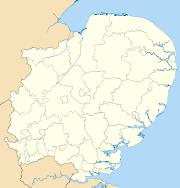
Hertfordshire Bedfordshire Cambridgeshire Cambridge • East Cambridgeshire • Fenland • Huntingdonshire • Peterborough • South Cambridgeshire
Norfolk Suffolk Cities of the United Kingdom England Bath · Birmingham · Bradford · Brighton and Hove · Bristol · Cambridge · Canterbury · Carlisle · Chester · Chichester · Coventry · Derby · Durham · Ely · Exeter · Gloucester · Hereford · Kingston upon Hull · Lancaster · Leeds · Leicester · Lichfield · Lincoln · Liverpool · London · Manchester · Newcastle upon Tyne · Norwich · Nottingham · Oxford · Peterborough · Plymouth · Portsmouth · Preston · Ripon · St Albans · Salford · Salisbury · Sheffield · Southampton · Stoke-on-Trent · Sunderland · Truro · Wakefield · Wells · Westminster · Winchester · Wolverhampton · Worcester · York
Scotland Wales Northern Ireland Categories:- Cambridge
- Cities in the East of England
- County towns in England
- Local government in Cambridgeshire
- University towns in the United Kingdom
- Non-metropolitan districts of Cambridgeshire
- Local government districts of the East of England
Wikimedia Foundation. 2010.

